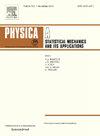Geodesic learning
IF 2.8
3区 物理与天体物理
Q2 PHYSICS, MULTIDISCIPLINARY
Physica A: Statistical Mechanics and its Applications
Pub Date : 2025-03-13
DOI:10.1016/j.physa.2025.130539
引用次数: 0
Abstract
Learning is a fundamental characteristic of living systems, enabling them to comprehend their environments and make informed decisions. These decision-making processes are inherently influenced by available information about their surroundings and specific objectives. There is an intriguing perspective is that each process is highly efficient under a given set of conditions. A key question, then, is how close to optimality it is or how efficient it is under given conditions. Here, the concept of geodesic learning as the optimal reference process, with which each process can be compared, is introduced and formulated on the basis of geometry. The probability distribution describing the state of the composite system consisting of the environment, termed the information bath, and a decision-maker is described by use of the entropic quantities. This enables one to study the system in analogy with thermodynamics. Learning processes are expressed as the changes of parameters contained in the distribution. For a geometric interpretation of the processes, the manifold endowed with the Fisher-Rao metric as the Riemannian metric is considered. This framework allows one to conceptualize the optimality of each process as a state change along a geodesic curve on the manifold, which gives rise to geodesic learning. Then, the bivariate Gaussian model is presented, and the processes of geodesic learning and adaptation are analyzed for illustrating this approach.
测地学习
学习是生命系统的基本特征,使它们能够理解环境并做出明智的决定。这些决策过程本质上受到有关其周围环境和特定目标的现有信息的影响。有一个有趣的观点是,在给定的一组条件下,每个过程都是高效的。那么,一个关键问题是,在给定条件下,它离最优状态有多近,或者它的效率有多高。在这里,引入了测地线学习作为最优参考过程的概念,并在几何的基础上对每个过程进行了比较。描述由环境(称为信息池)和决策者组成的复合系统状态的概率分布是用熵量来描述的。这使人们能够用热力学的类比来研究这个系统。学习过程表示为分布中包含的参数的变化。对于这一过程的几何解释,考虑了具有Fisher-Rao度规作为黎曼度规的流形。这个框架允许人们将每个过程的最优性概念化为流形上沿测地线曲线的状态变化,从而产生测地线学习。然后,提出了二元高斯模型,并分析了测地线学习和自适应过程来说明该方法。
本文章由计算机程序翻译,如有差异,请以英文原文为准。
求助全文
约1分钟内获得全文
求助全文
来源期刊
CiteScore
7.20
自引率
9.10%
发文量
852
审稿时长
6.6 months
期刊介绍:
Physica A: Statistical Mechanics and its Applications
Recognized by the European Physical Society
Physica A publishes research in the field of statistical mechanics and its applications.
Statistical mechanics sets out to explain the behaviour of macroscopic systems by studying the statistical properties of their microscopic constituents.
Applications of the techniques of statistical mechanics are widespread, and include: applications to physical systems such as solids, liquids and gases; applications to chemical and biological systems (colloids, interfaces, complex fluids, polymers and biopolymers, cell physics); and other interdisciplinary applications to for instance biological, economical and sociological systems.

 求助内容:
求助内容: 应助结果提醒方式:
应助结果提醒方式:


